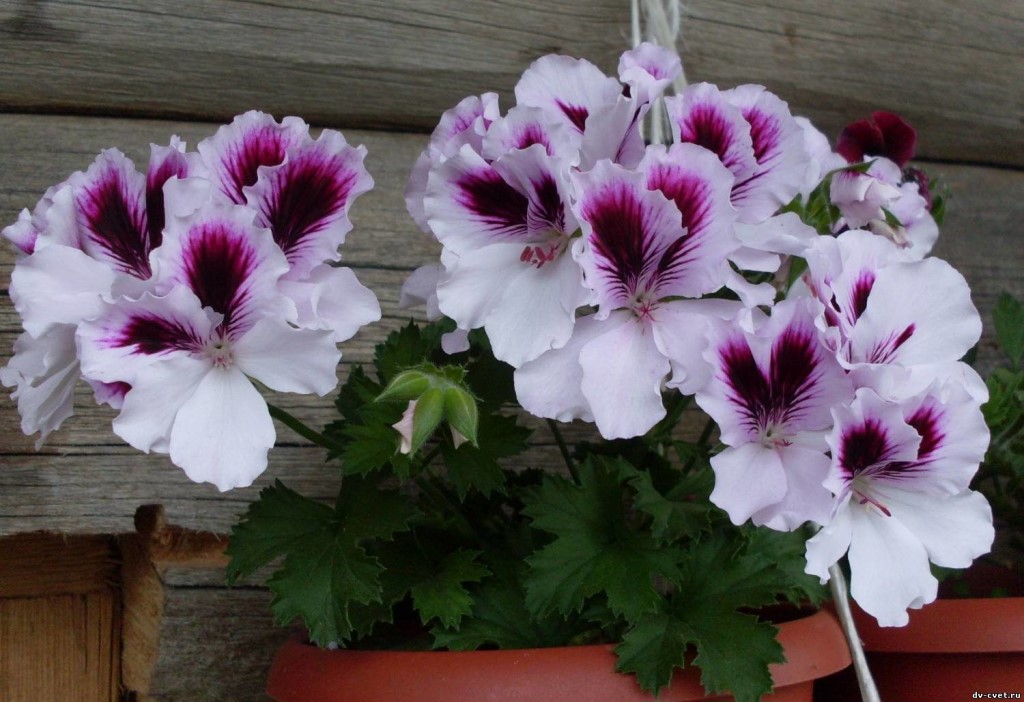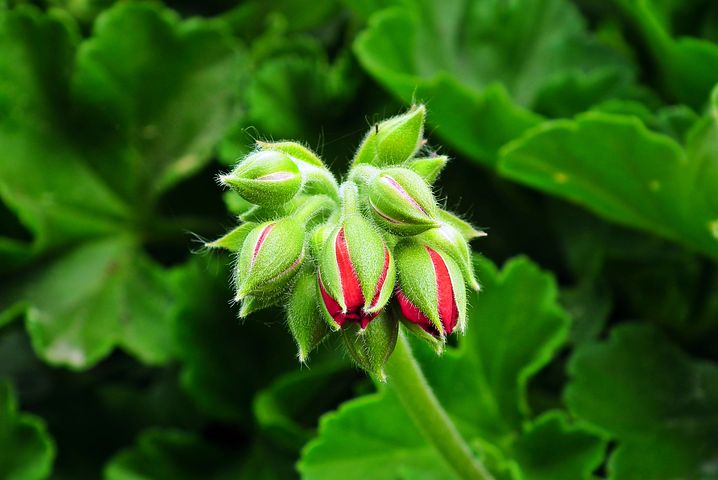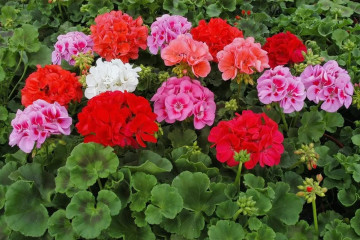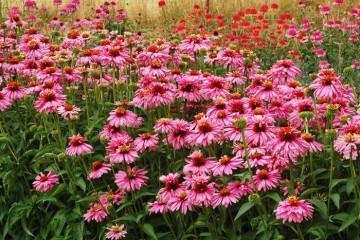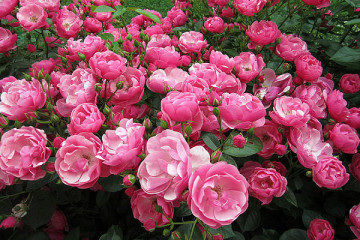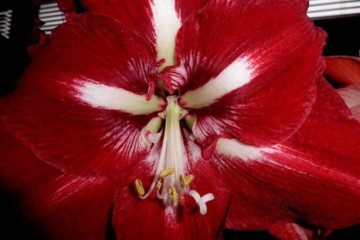Pelargonium Yug Shukar, Aksinya, Ireland and other varieties
Content:
Yug Shukar pelargonium is one of the popular varieties. Saturated burgundy inflorescences attract large size. They stand out effectively against a green background.
Description
Russian breeder Yulia Gonchar presented the world with many varieties of geraniums.
Unlike other varieties, representatives of the YUG group have a compact size and beautiful flowering.
A brief history of the appearance of flowers of the YUG group
India has long been considered the homeland of pelargonium, but only recently have scientists been able to establish the exact origin of the plant. It originally appeared in South America.
Active breeding began in 1951 in England. Hobbyists and experienced growers have grown new varieties to improve the characteristics of flowers.
Julia Gonchar (South) was no exception. She wanted to get compact geraniums that would have large inflorescences. Over time, the breeder's work was crowned with success and she created many new plants.
For example, Pelargonium Yug Aksinya has double inflorescences of delicate red color with a barely noticeable white center. The small size of the copies allows them to be kept in apartments and tiny rooms. Dwarf sizes do not make pelargonium ugly, on the contrary, at such a height, the inflorescence plants look spectacular.
Varieties
The Yug group currently includes many varieties. They come in different colors and this allows collectors to take an interest in new species. The shades of some varieties of pelargonium change during the flowering process. For example, like Yug Varvara-Krasa pelargonium.
Popular varieties:
- YUG Shukar - rich burgundy color of petals, size about 50 cm, requires the formation of a crown.
- SOUTH Yadviga pelargonium - flowers of a gentle pink color, does not require pruning, the leaves are green. Average height 40 cm.
- SOUTH Sakura - the name comes from the plant of the same name. The center of the flower is crimson, the rest is light pink. The leaves are serrated.
- Pelargonium Varvara-Krasa is a dwarf size, the height does not exceed 30 cm. Terry flowers are similar in shape to peonies. The color is white-pink. Blooms for a long time.
- SOUTH Zlatoslav - Bright pink inflorescences. The leaves are green with a slight golden tint.
- SOUTH Claudia - the flowers are snow-white, double, the size of the plant is dwarf, the formation of the crown is not required.
- YUG Princess Grace is an original variety. The white petals are decorated with a dark pink border.
- Pelargonium SOUTH Ireland - white flowers, sometimes greenish in the middle and outside of the petals. Does not require the formation of a bush.
- SOUTH Yesenia - pink flowers with reddish veins, the edges of the petals are pinkish-white.
- YUG Nina - golden foliage. The flowers are densely double, lavender-pink. The bush forms on its own.
Care
Pelargonium Yug Shukar needs the right conditions of detention. The abundance of flowering and the life of the flower depend on this.
Factors required for growing a flower:
- Illumination - diffused light, during the flowering period the duration of daylight hours is at least 8 hours.
- Temperature - in the warm season - 23 ° C, in the winter - 15 ° C.
- Watering - during the flowering period, the plant is watered once a week, since stagnant moisture leads to the development of gray rot. In winter, the number of watering is reduced to 1 time in 10 days. The humidity level is maintained at 60%.SOUTH Sigal pelargonium and others do not need spraying.
- Top dressing - during flowering, a universal remedy for flowering plants is added once a week. The soil should be loose and nutritious.
- The size of the pot is 1 cm larger than the earthen lump.
- Pruning - dwarf varieties do not need to form stems, taller specimens can be pinched in the spring. The transplant is carried out once a year.
Features of periods of development
The plant has two time periods per year - dormancy and active growth. They must be changed periodically, otherwise the geranium will not live long.
Periods
Growth time is in the spring and summer. From about mid-April, pelargonium wakes up from hibernation and begins to grow. At this time, bud formation and flowering take place.
Rest preparation begins around September. During this period, the plant is not transplanted, fed or rearranged. It is advisable to reduce the temperature, the number of waterings and the length of daylight hours.
Geraniums wake up gradually. To do this, they are gradually returned to their usual conditions of detention, imitating the change of seasons in nature.
Types of flowers
Varieties differ not only in size and color. Pelargonium Yug Dey, for example, has double petals - this makes the flowers voluminous, lush, beautiful. They are called terry.
Varieties can have different flower shapes. For example, in tulip pelargonium, they resemble tulips. This also applies to rosaceous species. The Deacons look especially beautiful. In such a geranium, flowers are collected in a small bunch.
Reproduction methods
The easiest way to breed pelargonium with shoots. To do this, it is enough to cut the stalk, put it in water or plant it in the ground. It takes 2-3 weeks for the roots to germinate, after which the plant needs to be looked after as usual.
Additionally, you can use stimulants for the development of the root system, for example, "Kornevin". It is better to do this in the spring, when the geranium is gaining strength.
Another breeding option is with seeds that are sold in specialized stores. They are planted in shallow containers in March. The first shoots appear at 3-4 weeks, picking is carried out at 6 weeks after sowing. This growing method is difficult for indoor conditions.
Diseases and pests
When the soil is waterlogged, gray rot appears, which is easy to visually detect by characteristic spots. The affected parts are removed and the plant is treated with a fungicide.
In dry air, rust appears on the leaves of pelargonium. The treatment is the same as for gray mold. The disease can be identified by the characteristic brown bloom on the leaves.
With a lack of air humidity, the plant infects a spider mite. Its presence is determined by the characteristic spider web on the geranium. To destroy the pest, the entire plant is sprayed with an insecticide.
Aphids are also easy to see visually. It attaches to the outside of the leaf and to the stems. Insects are gently cleaned off with a cotton swab, and geraniums are washed with soapy water and treated with an insecticide.
The description of the variety does not always give a complete picture of the characteristics of a particular pelargonium. Carefully study the recommendations for care, this will preserve the plant for many years.

